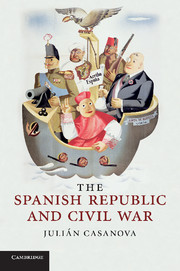Book contents
- Frontmatter
- Contents
- List of maps
- Chronology
- Introduction
- Part I Republic
- Part II Civil war
- 6 From coup d'état to civil war
- 7 Order, revolution and political violence
- 8 An international war
- 9 The Republic at war
- 10 ‘Nationalist’ Spain
- 11 Battlefields and rearguard politics
- Epilogue: Why did the Republic lose the war?
- Glossary
- Appendix 1 Leading figures
- Appendix 2 Political parties and organisations
- Index
- References
7 - Order, revolution and political violence
Published online by Cambridge University Press: 05 June 2012
- Frontmatter
- Contents
- List of maps
- Chronology
- Introduction
- Part I Republic
- Part II Civil war
- 6 From coup d'état to civil war
- 7 Order, revolution and political violence
- 8 An international war
- 9 The Republic at war
- 10 ‘Nationalist’ Spain
- 11 Battlefields and rearguard politics
- Epilogue: Why did the Republic lose the war?
- Glossary
- Appendix 1 Leading figures
- Appendix 2 Political parties and organisations
- Index
- References
Summary
The military rebels gave a taste of their sword to tens of thousands of citizens. Nobody knew better than they did how useful terror could be to paralyse any potential resistance and eliminate their opponents. Many of them had cut their teeth in the colonial wars, ideal settings for learning to reject human values and civic virtues, to become educated in the veneration of violence. The premeditated violence before the coup, during the plotting stage, was nothing compared to what was to begin in July 1936. They started by spreading terror from the very first day, intimidating, killing, crushing any resistance. With the declaration of martial law, anyone defending the Republic was deemed a ‘rebel’.
When the military coup evolved into a war, the destruction of the enemy became the absolute priority. And in this transition from politics to war, the opponents, either political or ideological, lost their status as compatriots, ‘Spaniards’, and became an enemy against whom the use of violence was totally legitimate. ‘If I see my father in the enemy ranks, I shoot him’, said General Mola. War was no longer the continuation of politics by other means, as Karl von Clausewitz, the leading military theorist of the nineteenth century, had written. A century later, it was a case of using it to resolve social conflicts, something which matched perfectly the pattern of that turbulent epoch of wars, revolutions, Fascism and democracies in crisis.
- Type
- Chapter
- Information
- The Spanish Republic and Civil War , pp. 179 - 211Publisher: Cambridge University PressPrint publication year: 2010

